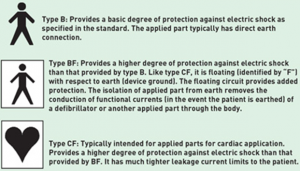Medical products need to comply with relevant parts of EN 60601-1 (e.g. EN 60601-1-2)
Good resource sites
Indicators And Buttons
Red or yellow indicator lights, buttons or switches must not be used for general items as these have special meaning.
Connectors
Connectors on patient leads must not be of a type in common use, e.g. 9-pin D-type, keyboard connector, etc., to prevent the possibly of the patient being inadvertently connected to an unsafe device or port.
IP Rating
Is there is a requirement for the product to prevent the ingress of liquids which the design therefore needs to ensure?
Component Choices
As the developer of an electrical medical device, you will probably use components manufactured by other companies. Those components, which may influence the safety of your product, are known as safety critical. When you submit your product to a laboratory for testing to IEC 60601-1, the test engineer will want to have proof of the compliance of these components. All components carrying mains voltage are considered safety critical. Such components include: mains transformers, mains switches, fuses, fuseholders, appliance inlets, EMI filters. Other components having a specific safety function are also considered safety critical, e.g. thermoswitches, optocouplers, interlock switches, etc. Battery charging circuits are also considered safety critical.
It is generally in your interest to use components which already have approvals to North American (e.g. UL, CSA) and European (e.g. TUV, VDE, Demko, etc.) test houses. In most cases you should ask the component manufacturer for a copy of the component approval certificate. The engineer who tests your product will ask to see this. Be wary of component manufacturers’ use of phrases such as ‘conforms to’, ‘compliant with’ or ‘designed to as this often means that there is no third party approval of the component.
Electrical Design Requirements
IEC 60601-1 requires that two levels of protection be employed in various areas of the product to meet the requirements of the standard. If one level of protection fails, the product would then still have another level of protection to contain any electrical shock hazards and shield patients and operators from harm.
IEC 60601-1 permits three building blocks to be used in various combinations to meet the “two levels of protection” requirement. These building blocks are insulation, protective earthing, and protective impedance. For example, a protective earth (one level of protection) used in combination with basic insulation (one level of protection) provides the two levels of protection that are required. Alternatively, a product’s plastic enclosure that has reinforced insulation (considered two levels of protection) between the outside of the enclosure and its circuits again achieves two levels of protection.
Protection against Electrical Shock
For devices powered by an external source, the product may be classified as Class I or II. Class I is a product that is provided with a reliable protective earth (PE), such as a complete metal enclosure, that is protectively tied to the ground pin of the three-pronged power plug. Construction is such that accessible metal parts cannot become live in the event of a single fault. Class II is a product without a PE and where double or reinforced insulation is relied upon to provide protection against electric shock. For example, a product has an external brick power supply that provides double insulation. The Class II symbol is a double-walled square, indicating the product’s double insulation.
Degree of Protection (Applied Part) against Electric Shock
This product classification deals with the definition of applied parts—those parts or circuits that deliberately come in physical contact with the patient. The classification applies to each applied part. They are classified either as type B, BF or CF, depending on the degree of protection they offer against electric shock
Type BF and CF are ‘floating’ and must be separated from earth.
Patient connections, particularly Type BF and Type CF, must be isolated from other secondary circuitry used for signal input/output ports. This protects the patient if, as a result of faults on external equipment, dangerous voltages appear on communication lines.
Software Design Requirements
IEC 62304 is a harmonised standard for software design in medical products adopted by the European Union and the United States. It came into force in 2010.
Resources
http://www.emdt.co.uk/article/developing-medical-device-software-iso-62304


